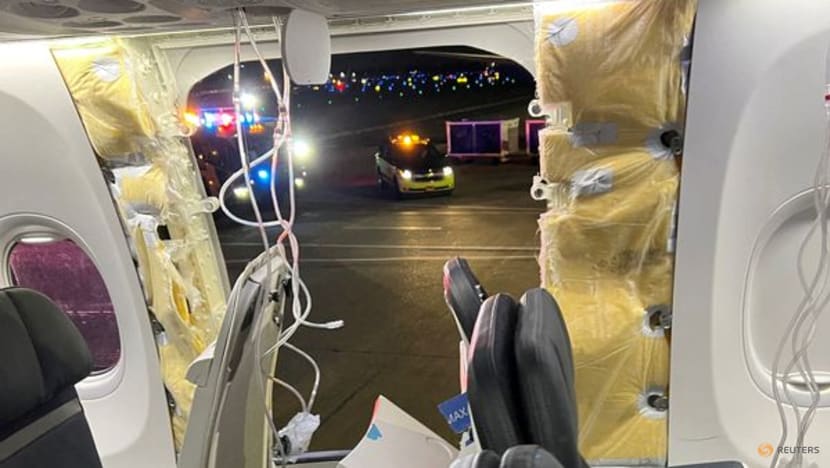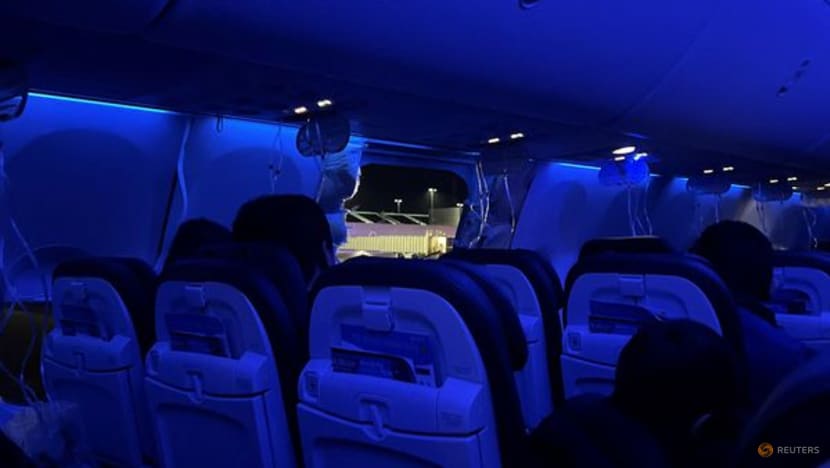Commentary: Boeing 737 MAX blowout on Alaska Airlines flight points to pervasive flaws
The grounding of Boeing MAX 9 aircraft after a fuselage section came apart mid-air on an Alaska Airlines flight adds to the planemaker’s long list of problems, says Bloomberg Opinion's Brooke Sutherland.

This audio is AI-generated.
BOSTON: Boeing’s 737 MAX jet was supposed to be the safest plane in the world. The perception is anything but.
Almost five years after the second fatal crash involving the plane prompted a global grounding, and three years after the Federal Aviation Administration (FAA) said the MAX could safely return to US skies, the aircraft is still having troubling safety problems.
The FAA on Saturday (Jan 6) ordered a temporary grounding and immediate inspections of certain Boeing 737 MAX 9 aircraft after a piece of the plane blew off soon after takeoff on a late Friday evening Alaska Airlines flight, leaving a gaping hole with views of the starry night where a panel should have been.
Alaska Air Group had already stopped flying its entire fleet of the Boeing MAX variant following the incident, while United Airlines Holdings had also pulled some of the model from service to conduct emergency inspections.
The FAA order affects about 171 planes worldwide. The Alaska Airlines flight was carrying 171 passengers and six crew members from Portland, Oregon, to Ontario, California. The plane in question was brand new, having been delivered only in October 2023.
A CHECKERED HISTORY
When passengers board planes, they should be prepared for possible delays, especially these days amid an onslaught of weather disruptions and the quagmires of an overtaxed aviation infrastructure. They should not be prepared for the plane to literally come apart in front of their eyes.
Accidents do happen: A woman died in 2018 after a mid-flight engine explosion on a Southwest Airlines flight sent metal shrapnel into the fuselage, shattering the window she was seated next to on the Boeing 737-700 jet (a predecessor to the MAX).
It’s too soon to say whether there’s a systemic problem that makes the panels on the MAX fuselage prone to blowing off. Alaska Airlines separately said it had completed inspection on “more than a quarter” of its 737 MAX 9 fleet as of midday Saturday without any "concerning findings". But it’s not too early to say that the Boeing culture and aerospace supply chain that produced this plane have systemic flaws that have not yet been properly addressed.
Given the plane’s checkered safety history, you can hardly blame Alaska for erring on the side of caution and grounding the entire fleet of the MAX variant involved in the accident.
China’s aviation regulator is conducting an emergency meeting to consider a response to the incident, including a possible grounding of the Boeing MAX fleet in the country, Bloomberg News reported, citing people familiar with the matter. The version of the MAX involved in the Alaska Air incident isn’t flown by Chinese carriers. But the country was the first to ground the MAX after its crashes and the last to restart commercial service amid heightened trade tensions with the US and air travel disruptions from the pandemic.
Boeing had 250 MAX planes sitting in inventory as of the third quarter, 85 of which were being held for Chinese customers. Analysts had been growing increasingly optimistic that Boeing would soon restart 737 deliveries to China (and pocket the associated cash flow), but fresh safety questions and quality control issues may delay that key benchmark yet again.
“It’s getting difficult to keep track of all of Boeing’s myriad production issues, regulatory holdups, delivery delays and charges,” I wrote in April 2023. That was when the company warned that two of the rear fittings that attach the 737 MAX jet’s vertical tail to the body of the plane had been installed incorrectly by supplier Spirit AeroSystems Holdings.
In August, Boeing and Spirit disclosed another, separate production glitch affecting the structure of the MAX: Fastener holes in a component that helps maintain cabin pressure had been drilled improperly. This particular issue has proved costly and time-consuming to fix because mechanics must assess each hole by X-ray and, in many cases, work around already installed lavatories, kitchen galleys and overhead bins.
Boeing in October lowered its 2023 delivery target for the MAX. In late December, the FAA said it was monitoring targeted inspections of MAX jets for loose bolts after an international operator discovered a missing nut while performing routine maintenance on the rudder-control system.
The two MAXcrashes - which killed a total of 346 people - were tied to flight control software that was originally added to guard against an aerodynamic stall but was activated by a single sensor that malfunctioned and instead repeatedly forced the planes to nose-dive, setting off a cacophony of alerts that overwhelmed the pilots.
In addition to requiring operating changes to that system, known as the manoeuvring characteristics augmentation system (MCAS), the FAA also required a broader overhaul of the plane’s computers to improve reliability and the separation of bundles of electrical wiring that had the potential to short-circuit.
I’m probably forgetting something, but those are just the MAX's woes and fixes.
Deliveries of the 787 Dreamliner were halted for more than a year as the company grappled with tiny wrinkles in the carbon fibre frame and regulatory scrutiny of its production process; the commercial rollout of the jumbo 777X jet has been significantly delayed until 2025; and the company keeps having to take writedowns on its defence programmes as its past strategy of bidding low for fixed-priced contracts on the expectation that future service work would make up the difference continues to prove ill-advised.
In the wake of the MAX crisis, Boeing has toughened up internal accountability safeguards and safety reporting protocols in its engineering ranks. The company also seems to finally have realised that pushing its suppliers to the brink is bad for business.
Boeing agreed in October to adjust contracts on the 737 and 787 programmes for Spirit AeroSystems in a bid to stave off a potential cash-flow crisis at the key supplier.
While the deal arguably only deepens a lopsided relationship that some analysts have compared to indentured servitude, it’s a far cry from Boeing’s pre-crisis “partnering for success” programme that sought to squeeze costs out of suppliers and wring out higher profit margins for itself. Component makers referred to the programme as "pilfering from suppliers".

BOEING IN SERIOUS NEED OF FRESH EYES
But Boeing chief executive officer Dave Calhoun has continuously pushed back on the idea that the company's challenges are the result of deep-rooted cultural problems and resisted calls for more sweeping overhauls of the engineering and management ranks. He’s positioned himself as an outsider, even though he’s been on Boeing’s board since 2009 and as such arguably bears about as much responsibility for the company’s legacy of missteps as anyone else.
A surprising number of CEOs at Boeing clients were openly calling for management changes in mid-2022. The chorus of criticism has quieted recently but might resume should this latest MAX setback prove structural in nature.
The company announced in December that Stephanie Pope, the head of its services arm, will become chief operating officer. The position is often considered a stepping stone and sets Pope up to eventually succeed Calhoun when he retires.
As I wrote at the time, Pope is immensely qualified for the CEO position, and it’s nice to see Boeing finally consider a woman for the top job. But the seemingly never-ending string of quality control issues emanating out of Boeing suggests that this is still a company in serious need of fresh eyes.
The slap-on-the-wrist deferred prosecution agreement that Boeing entered into with the US Justice Department in connection with the 737 MAX crisis concluded that "misconduct was neither pervasive across the organisation, nor undertaken by a large number of employees, nor facilitated by senior management".
How many more issues have to emerge with Boeing airplanes before we can finally start calling this a pervasive problem? It seems as if we passed that point long ago.






